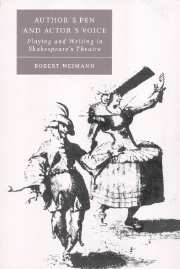Book contents
- Frontmatter
- Contents
- Preface
- Introduction: conjunctures and concepts
- 1 Performance and authority in Hamlet (1603)
- 2 A new agenda for authority
- 3 Pen and voice: versions of doubleness
- 4 Playing with a difference
- 5 Histories in Elizabethan performance
- 6 Hamlet and the purposes of playing
- 7 Space (in)dividable: locus and platea revisited
- 8 Shakespeare's endings: commodious thresholds
- Afterword: thresholds forever after
- Notes
- List of works cited
- Index
3 - Pen and voice: versions of doubleness
Published online by Cambridge University Press: 22 September 2009
- Frontmatter
- Contents
- Preface
- Introduction: conjunctures and concepts
- 1 Performance and authority in Hamlet (1603)
- 2 A new agenda for authority
- 3 Pen and voice: versions of doubleness
- 4 Playing with a difference
- 5 Histories in Elizabethan performance
- 6 Hamlet and the purposes of playing
- 7 Space (in)dividable: locus and platea revisited
- 8 Shakespeare's endings: commodious thresholds
- Afterword: thresholds forever after
- Notes
- List of works cited
- Index
Summary
As the Prologue to Troilus and Cressida begins to address the audience, his unabashed assurance of place (“In Troy, there lies the scene,” 1.1) gives way to a strange kind of anxiety, a distinct lapse of assurance about both the text and the acting of the play.
and hither am I come,
A Prologue arm'd, but not in confidence
Of author's pen or actor's voice, but suited
In like conditions as our argument (22–25)
The question that I propose to ask is whether and to what extent this want of “confidence” can be read in conjunction with a late Elizabethan difficulty in coming to terms with the circulation of authority between writing and performing in the theatre. Clearly, the representation of textually inscribed meaning (deriving from “author's pen” and the matter of history, myth, or romance) and the practice of performance (requiring the physical, audible presence of “actor's voice” and body) are not the same. Rather than identifying with either of these, Shakespeare's Prologue is “suited / In like conditions as our argument.” In other words, his appearance is warlike. While in opening the play he presents “the scene” to the audience, he also and simultaneously represents, is even costumed, or “suited,” to stand for “our argument.”
- Type
- Chapter
- Information
- Author's Pen and Actor's VoicePlaying and Writing in Shakespeare's Theatre, pp. 54 - 78Publisher: Cambridge University PressPrint publication year: 2000



